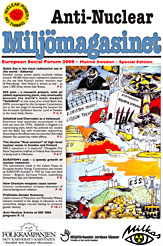Forsmark NPP
Huge amounts of Uranium in sediments around Forsmark
Forsmark site investigation. Analysis of radioactive isotopes in near surface groundwater,surface water, biota and soil”. By Sara Grolander, Svensk Kärnbränslehantering AB. Per Roos, Risø National Laboratory.
December 2009 Download Swedish: SKB Uran Forsmark Dec 2009
BSRRW: The conclusion that Uranium isotopes around Forsmark NPP do not exceed the natural backgound radiation are based on the wrong ICRP model.
Forsmark Nuclear Power Plant had “the most serious nuclear incident in the world since the Chernobyl disaster” and it was pure luck that prevented a meltdown
For swedish info on the 25th July 2006 Forsmark accident: on left side of this screen – click Sweden.
http://en.wikipedia.org/wiki/Forsmark_Nuclear_Power_Plant
“On 25 July 2006, one reactor was shut down after an electrical fault. According to the Swedish Nuclear Power Inspection authority SKI the incident was rated 2 on the International Nuclear Event Scale. According to Lars-Olov Höglund, a former construction chief at Vattenfall, it is the most serious nuclear incident in the world since the Chernobyl disaster and it was pure luck that prevented a meltdown. Both the SKI and the safety chief of Forsmark power plant disagree with that opinion and state that the incident was serious but the description provided by Höglund was incorrect and there was no risk of a meltdown.
Lars-Olov Höglund has been involved in a personal legal dispute with Forsmark Nuclear powerplant for several years.
However, SKI also writes about the failing safety system in that finding out that safety functions proved to be linked together in a vounorable way are an extremely serious issue”
The official Forsmark NPP website, in swedish
(You may google translate it)
http://www.vattenfall.se/www/vf_se/vf_se/518304omxva/518334vxrxv/518814vxrxe/519534forsm/index.jsp
Close to Meltdown – The Incident in July 2006
Here is a clip from the swedish video “Med Säkerhet som Insats” (The security operation), where you can hear Kjell Olsson, emergency manager and investigator at the Nuclear Power Inspectorate, making statements about the Forsmark incident the 25th July 2006. Kjell Olsson admits that there was a risk of meltdown. Nuclear Power Inspectorate was swedish Statens KärnkraftsInspektion then, SSM.se now.
Video about Forsmark incident, 25th July 2006. “Med säkerhet som insats” Makan Amini
In Swedish
http://video.google.com/videoplay?docid=-1129174823495821532
Translation of the swedish wiki Forsmark NPP
http://sv.wikipedia.org/wiki/Forsmarks_k%C3%A4rnkraftverk#Incidenten_i_juli_2006
“In July 2006 a maintenance work was carried out by Swedish National Power Grid by the switchyard outside of Forsmark 1. Some failure in the work routine occurred which created a non effective switchyard; earth ground was still leading to a short circuit when power was put on the 25th July at 13:20. Voltage reproduction went through the power plant and electrical system for a few seconds varied in tension between about 80 and 120% of what they are supposed to be. Reactor power was regulated automatically and instantly brought down. It stroke out some of the equipment, including heater switch, rectifier and inverters. In such an event the nuclear plants own redundant electrical systems should be able to take over electricity supply. However the power plant has four Diesel Generators and batteries to ensure a supply of electricity at all times. But only two of the four diesel generators started. It suffices; however, the two of the generators to start to create a secure power supply, which must be ensured. After 23 minutes the two remaining generators started manually. Although the reactor is stopped so fast it needs to continue cooling. Supply of power from the batteries was also knocked out because of transients and several overvoltages. This led to a number of important safety systems, computers and measuring instruments getting knocked out. After about 30 seconds the reactor was shut down scram. Several very important instruments, such as for measuring the water level in the reactor were knocked out or were not reliable.
State Nuclear Power Inspectorate (Statens kärnkraftinspektion, SSM now) classified the event as “very serious”. The incident is classified as an INES 2 (scale 0-7), which means “The deterioration in the plant defense in depth (the deterioration of plant safety)” and belonging to the three lowest levels.
On August 1, Lars-Olov Höglund claimed in the media that Unit 1 at Forsmark was close to a meltdown. Ingvar Berglund who is head of safety and environment at the Forsmark nuclear power station, however believes that Höglund description is totally inaccurate. Höglund’s impartiality has been questioned because he has long running litigations against both the Forsmark and Ringhals as he asks for millions in damages to his business, as he himself has been unfairly treated in the procurement of these proceedings. Nevertheless Kjell Olsson, an analyst at SKI, recognizes later that Höglund was right when he said that technically speaking at the power plant there could truly have occurred a meltdown. One should remember that Forsmark meltdown would not entail the same consequences as Chernobyl, where the hot steam caused the explosion, but only the reactor would have been destroyed inside Forsmark with no release of radioactive particles. After some work to improve the safety culture, safety and reliability of nuclear power, plant was started again and due to the inspection of IAEA is now considered the nuclear power plant of high international standards.”
Nuclear plant ‘could have gone into meltdown’
Published: 1 Aug 06 15:18 CET
Online: http://www.thelocal.se/4487/20060801/

